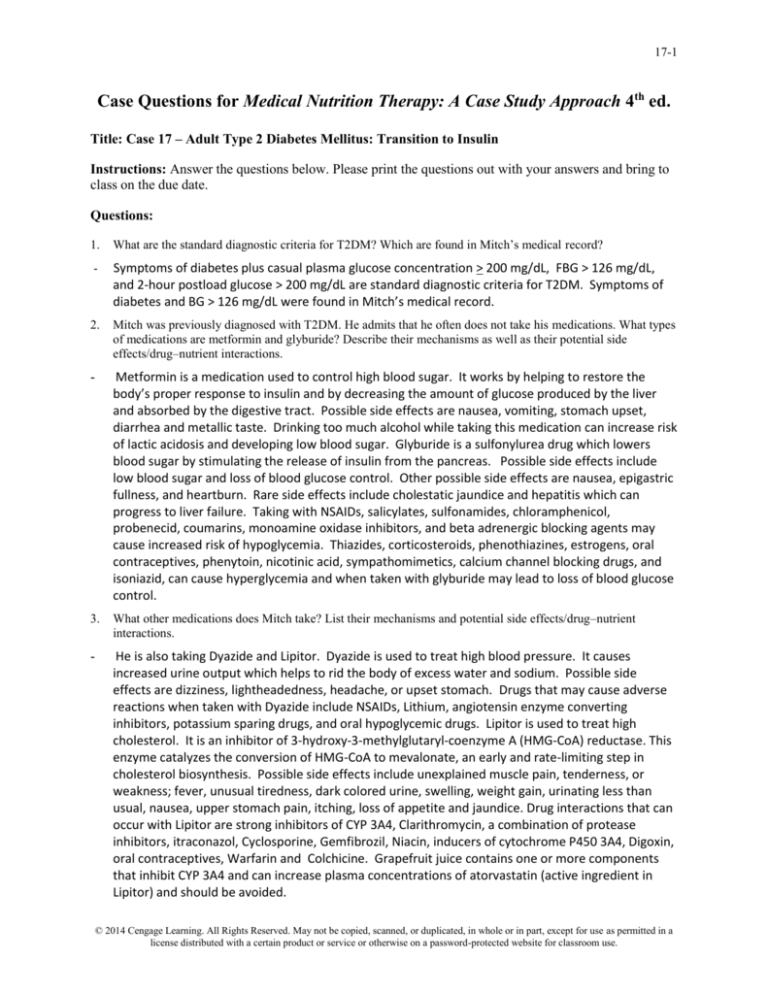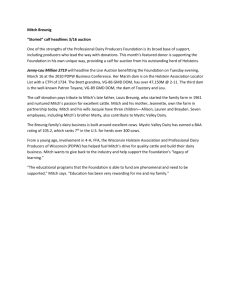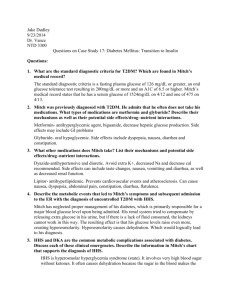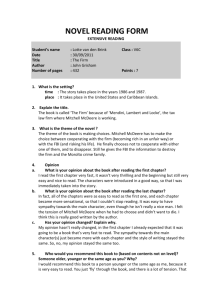
17-1
Case Questions for Medical Nutrition Therapy: A Case Study Approach 4th ed.
Title: Case 17 – Adult Type 2 Diabetes Mellitus: Transition to Insulin
Instructions: Answer the questions below. Please print the questions out with your answers and bring to
class on the due date.
Questions:
1.
What are the standard diagnostic criteria for T2DM? Which are found in Mitch’s medical record?
-
Symptoms of diabetes plus casual plasma glucose concentration > 200 mg/dL, FBG > 126 mg/dL,
and 2-hour postload glucose > 200 mg/dL are standard diagnostic criteria for T2DM. Symptoms of
diabetes and BG > 126 mg/dL were found in Mitch’s medical record.
2.
Mitch was previously diagnosed with T2DM. He admits that he often does not take his medications. What types
of medications are metformin and glyburide? Describe their mechanisms as well as their potential side
effects/drug–nutrient interactions.
-
Metformin is a medication used to control high blood sugar. It works by helping to restore the
body’s proper response to insulin and by decreasing the amount of glucose produced by the liver
and absorbed by the digestive tract. Possible side effects are nausea, vomiting, stomach upset,
diarrhea and metallic taste. Drinking too much alcohol while taking this medication can increase risk
of lactic acidosis and developing low blood sugar. Glyburide is a sulfonylurea drug which lowers
blood sugar by stimulating the release of insulin from the pancreas. Possible side effects include
low blood sugar and loss of blood glucose control. Other possible side effects are nausea, epigastric
fullness, and heartburn. Rare side effects include cholestatic jaundice and hepatitis which can
progress to liver failure. Taking with NSAIDs, salicylates, sulfonamides, chloramphenicol,
probenecid, coumarins, monoamine oxidase inhibitors, and beta adrenergic blocking agents may
cause increased risk of hypoglycemia. Thiazides, corticosteroids, phenothiazines, estrogens, oral
contraceptives, phenytoin, nicotinic acid, sympathomimetics, calcium channel blocking drugs, and
isoniazid, can cause hyperglycemia and when taken with glyburide may lead to loss of blood glucose
control.
3.
What other medications does Mitch take? List their mechanisms and potential side effects/drug–nutrient
interactions.
-
He is also taking Dyazide and Lipitor. Dyazide is used to treat high blood pressure. It causes
increased urine output which helps to rid the body of excess water and sodium. Possible side
effects are dizziness, lightheadedness, headache, or upset stomach. Drugs that may cause adverse
reactions when taken with Dyazide include NSAIDs, Lithium, angiotensin enzyme converting
inhibitors, potassium sparing drugs, and oral hypoglycemic drugs. Lipitor is used to treat high
cholesterol. It is an inhibitor of 3-hydroxy-3-methylglutaryl-coenzyme A (HMG-CoA) reductase. This
enzyme catalyzes the conversion of HMG-CoA to mevalonate, an early and rate-limiting step in
cholesterol biosynthesis. Possible side effects include unexplained muscle pain, tenderness, or
weakness; fever, unusual tiredness, dark colored urine, swelling, weight gain, urinating less than
usual, nausea, upper stomach pain, itching, loss of appetite and jaundice. Drug interactions that can
occur with Lipitor are strong inhibitors of CYP 3A4, Clarithromycin, a combination of protease
inhibitors, itraconazol, Cyclosporine, Gemfibrozil, Niacin, inducers of cytochrome P450 3A4, Digoxin,
oral contraceptives, Warfarin and Colchicine. Grapefruit juice contains one or more components
that inhibit CYP 3A4 and can increase plasma concentrations of atorvastatin (active ingredient in
Lipitor) and should be avoided.
© 2014 Cengage Learning. All Rights Reserved. May not be copied, scanned, or duplicated, in whole or in part, except for use as permitted in a
license distributed with a certain product or service or otherwise on a password-protected website for classroom use.
17-2
4.
Describe the metabolic events that led to Mitch’s symptoms and subsequent admission to the ER with the
diagnosis of uncontrolled T2DM with HHS.
-
Mitch did not take his medications regularly for lowering blood-glucose and his blood sugar became
too high. The high level of dissolved solutes in his blood caused him to become dehydrated. Too
many dissolved particles lower the water activity meaning that there is less water available for use
by the body.
5.
HHS and DKA are the common metabolic complications associated with diabetes. Discuss each of these
clinical emergencies. Describe the information in Mitch’s chart that supports the diagnosis of HHS.
-
HHS stands for Hyperglycemic Hyperosmolar state. It is a complication of Diabetes Mellitus in
which high blood glucose levels cause severe dehydration due to increased osmolality that can lead
to coma and even death. DKA stands for Diabetic Ketoacidocis. It is caused by decreased insulin
production or sensitivity which leads to the body to start burning fatty acids for fuel which produces
ketone bodies. Ketone bodies are acidic and when high levels build up in the blood and urine it
becomes poisonous. Mitch was diagnosed with T2DM one year ago and was admitted to the
hospital with extremely high blood sugar and severe dehydration. He was also positive for ketones.
6.
HHS is often associated with dehydration. After reading Mitch’s chart, list the data that are consistent with
dehydration. What factors in Mitch’s history may have contributed to his dehydration?
-
He was found in his home drowsy and confused. His skin was warm and dry, he had dry mucous
membranes and poor skin turgor. His temperature was high and he had low blood pressure. The
specific gravity of his urine was high and the urine was cloudy and amber colored. He also had high
osmolality.
7.
Assess Mitch’s intake/output record for the first 24 hours of his admission. What does this tell you? Assuming
that Mitch tells you that his usual weight is 228 lbs, can you estimate the volume of his dehydration?
-
His intakes are much higher than his outputs meaning he is still dehydrated. The volume of his
dehydration is about 6,300 ml.
8.
Mitch was started on normal saline with potassium as well as an insulin drip. Why are these fluids a component
of his rehydration and correction of the HHS?
-
The insulin is to help lower his blood glucose and the potassium is to decrease osmolality.
Potassium is the major cation in intracellular fluid so increasing potassium decreases the amount of
fluid in cells.
9.
Describe the insulin therapy that was started for Mitch. What is Lispro? What is glargine? How likely is it that
Mitch will need to continue insulin therapy?
-
He was started on an insulin drip. Lispro is a fast-acting insulin analog. Glargine is a long acting
basal insulin analog. His blood glucose is still really high, even after the insulin therapy. It is likely he
will need to continue.
10. Mitch was NPO when admitted to the hospital. What does this mean? What are the signs that will alert the RD
and physician that Mitch may be ready to eat?
-
NPO means nothing by mouth. If he has stabilized after 12 hours he can have clear liquids and if he
is able to keep them down and his vital signs are good he can progress to solid food, specifically a
consistent carbohydrate diet.
11. Outline the basic principles for Mitch’s nutrition therapy to assist in control of his DM.
© 2014 Cengage Learning. All Rights Reserved. May not be copied, scanned, or duplicated, in whole or in part, except for use as permitted in a
license distributed with a certain product or service or otherwise on a password-protected website for classroom use.
17-3
-
First he needs to get rehydrated, then he can progress from a clear liquid diet to solid foods. His
carbohydrate intake needs to be kept consistent to control his blood glucose levels so carb counting
is the most likely option.
12. Assess Mitch’s weight and BMI. What would be a healthy weight range for Mitch?
-
Mitch is 5’9 and weighs 214 pounds. His BMI is 31.8 so he falls into the category of obesity grade I.
A healthy weight range for Mitch would be 150 -165 pounds.
13. Identify and discuss any abnormal laboratory values measured upon his admission. How did they change after
hydration and initial treatment of his HHS?
-
His sodium levels were too low when he was admitted and were still too low after treatment,
though they were raised a little bit. His BUN was very high and decreased after treatment but was
still just a bit too high. His creatinine was too high upon admission and lowered with treatment
though remained a bit too high. His blood glucose was extremely high upon admission and lowered
significantly with treatment, but was still way too high. His inorganic phosphate was too low, but
was raised with treatment to almost normal levels. His osmolality was very high upon admission
and lowered with treatment but remained a bit too high. His cholesterol was too high when
admitted. His triglycerides were also too high. His HbA1c was way too high. His WBC was too high
and his hematocrit was too high. His urine specific gravity was too high, the pH too low. He also
tested positive for protein, ketones and glucose in urine. There was no data on any of these lab
values for after treatment.
14. Determine Mitch’s energy and protein requirements for weight maintenance. What energy and protein intakes
would you recommend to assist with weight loss?
-
Mitch’s energy requirements are 1,816 kcal per day (Mifflin St. Jeor). His protein requirements are
77.8- 97.3 g (0.8-1 g/kg). For weight loss I would recommend 1600-1800 kcals per day with about
60 g from protein.
15. Prioritize two nutrition problems and complete the PES statement for each.
-
Obesity class I RT excessive energy intake AEB usual dietary intake and BMI of 31.8.
Altered nutrition related lab values RT inconsistent carbohydrate intake AEB ↑BG ↑HbA1c and
usual dietary intake
16. Determine Mitch’s initial CHO prescription using his diet history as well as your assessment of his energy
requirements.
-
About 55% of kcals per day (247 grams)
17. Identify two initial nutrition goals to assist with weight loss.
-
1600-1800 kcals per day, At least 1 hour of physical activity per day
18. Mitch also has hypertension and high cholesterol levels. Describe how your nutrition interventions for diabetes
can include nutrition therapy for his other conditions.
-
Weight loss and physical activity should help with his hypertension. His diet could include making
sure he gets plenty of fiber and not too much fat to help lower his cholesterol. This should also help
with his hypertension.
19. Write an ADIME note for your initial nutrition assessment.
© 2014 Cengage Learning. All Rights Reserved. May not be copied, scanned, or duplicated, in whole or in part, except for use as permitted in a
license distributed with a certain product or service or otherwise on a password-protected website for classroom use.
17-4
Case: Fagan, Mitchell
Nutrition Assessment
Food & Nutrition History
Anthropometrics
Biochemical/Tests/Procedures
Usual intake
AM: coffe w/ half and half
Midmorning: bagel w/ cream
cheese, 2-3 c of coffee
Lunch: out at restaurant,
usually Jimmy John’s or fastfood sandwich, chips and diet
soda
Dinner: Cooks sometimes at
home—grilled chicken or
beef, salad, and potatoes or
rice. Often will meat friends
for dinner—likes all foods and
especially likes to try different
ethnic foods such as Chinese,
Mexican, Indian or Thai
Alcohol use: 3-4 drinks per
week
Ht:69”
Wt: 214 #
BMI: 31.8 Obesity grade I
IBW: 160#
%IBW: 133.8%
Nutrition Focused Physical
Find.
Client History
Sodium: 132mEq/L low
Potassium: 3.9 mEq/L normal
Chloride: 101 mEq/L normal
CO2:101mEq/L normal
BUN: 31mg/dL high
Creatinine: 1.9 mg/dL high
Glucose: 1524 mg/dL high
Phosphate, inorganic: 1.8 mg/dL low
Magnesium: 1.9 mg/dL normal
Calcium: 10 mg/dL normal
Osmolality: 360 mmol/kg/H2O high
Bilirubin total: 0.9 mg/dL normal
Bilirubin direct: 0.019 mg/dL normal
Protein total: 7.1 g/dL normal
Albumin: 4.9 g/dL normal
Prealbumin: 33 mg/dL normal
Ammonia: 15 µmol/L normal
Alkaline phosphatase: 112 U/L
normal
ALT: 21 U/L normal
AST: 17 U/L normal
CPK: 145 U/L normal
Lactate dehydrogenase: 275 U/L
normal
Cholesterol: 205 mg/dL high
HDL-C: 55 mg/dL normal
LDL-C: 123 mg/dL normal
LDL/HDL ratio: 2.26 normal
Triglycerides 185 mg/dL high
T4: 12 µg/dL normal
T3: 77 µg/dL normal
HbA1c: 15.2% high
C-peptide1.10 ng/dL normal
WBC:13.5 ×103/mm3 high
RBC: 6.1 × 106/mm3 normal
Hemoglobin: 14.5 g/dL normal
Hematocrit: 57 % high
Comparative Standards
Skin warm and dry; poor
turgor
53 y.o. male
Single, lives alone
Language: English only
Kcal: 1,816 (Mifflin St. Jeor)
Carb: 45-65%
© 2014 Cengage Learning. All Rights Reserved. May not be copied, scanned, or duplicated, in whole or in part, except for use as permitted in a
license distributed with a certain product or service or otherwise on a password-protected website for classroom use.
17-5
Drowsy, confused
Dry mucous membranes
Ethnicity: Caucasion
Occupation: retired military—
now works as consultant to
military equipment company
Hours of work: 8-5 daily
Type 2 DM ×1 yr
Medications: glyburide,
metformin, Dyazide, Lipitor
Family Hx: father- HTN, CAD
mother- type 2 DM
Pro: 77.8-97.3 g (0.8-1 g/kg)
Fat: 20-35%
Fluid: 2000-2500 ml
Fiber: 25 g
Nutrition Diagnosis
Nutritional Problem: Altered nutrition related lab values
Related to (etiology): Inconsistent carbohydrate intake
As evidenced by (signs & symptoms): Usual diet intake, ↑BG, and ↑HbA1c
Nutrition Intervention(s)
Nutrition Rx (NP-1.1): ~1800 kcal per day with ~55% of kcals from carbohydrate
Nutrition Education (Skill development E-2.2): provide education to client about carbohydrate counting
and self-glucose testing
Goal: modify carbohydrate intake to help lower BG and HbA1c
Nutrition Education (Priority modification E-1.2): provide education to client about benefits of physical
activity and ways to incorporate it into daily routine
Monitor/Evaluate
Energy intake (FH-1.1): Criteria- consume ~1800 kcal per day with ~55% of kcals from
carbohydrate
Weight (AD-1.1.2): Criteria- promote weight loss
Physical Activity (Consistency FH-7.3.2): Criteria- incorporate physical activity (at least 1
hour per day)
Glucose/endocrine profile (HgbA1c BD-1.5.3): Criteria- lower HgbA1c
Glucose/endocrine profile (Glucose, fasting BD-1.5.1): Criteria- lower BG
Electrolyte/renal profile (BUN BD-1.2.1): Criteria- lower BUN
Electrolyte/renal profile (Creatinine BD-1.2.2): Criteria- lower Creatinine
Lipid profile (Triglycerides, serum BD-1.7.7): Criteria- lower TG
© 2014 Cengage Learning. All Rights Reserved. May not be copied, scanned, or duplicated, in whole or in part, except for use as permitted in a
license distributed with a certain product or service or otherwise on a password-protected website for classroom use.






